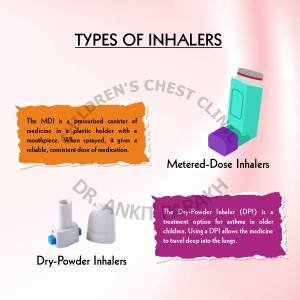Most common types of inhalers used for treatment of asthma in children and adolescents are metered dose inhalers (MDI) and dry powder inhalers (DPI).
What is a Metered Dose Inhaler (MDI)?
In a metered dose inhaler (MDI) the medicine is contained in an aluminium canister which is placed in a plastic canister. To release the medicine the patient presses down on the top of the canister which releases a defined quantity of the medicine. To take the inhaler the patient has to coordinate the actuation (pressing down on the inhaler) and taking a breath in. As this is quite difficult in children, spacers are always advocated to be used with inhalers. For details regarding the technique of correctly taking a metered dose inhaler (MDI) refer to the blog on How to take a metered dose inhaler (MDI) and spacer?
Advantages and disadvantages of a Metered Dose Inhaler (MDI)
Metered dose inhalers (MDI) when used with spacers allows young children to take the medicine appropriately. Metered dose inhalers (MDI) can be used at any age including infants. The amount of medicine which reaches the lungs with any device is maximum with metered dose inhalers (MDI) and spacers. In addition, a very low amount of medicine gets deposited in the throat hence reducing any side effects.

Metered dose inhalers (MDI) with spacers is the most versatile device which can be used at all ages. Some older children and adults find the spacer cumbersome to carry.
What is a dry powder inhaler (DPI)?
In a dry powder inhaler (DPI) the medicine is in the form of a dry powder as the name suggests. There are many types of dry powder inhaler (DPI) available. In single dose dry powder inhalers (DPI) the medicine is held in a capsule which requires it to be loaded in the hand-held device. While in multidose dry powder inhalers (DPI) the medicine is pre-loaded inside the inhaler.
In both types of dry powder inhalers (DPI) the medicine needs to be actuated and then inhaled. The inhalation process involves putting the mouthpiece of the dry powder inhalers (DPI) into the mouth and taking deep inhalation and holding their breath for 5–10 seconds. Dry powder inhalers (DPI) deliver the medication to the lungs as the person inhales through the device. For details regarding the technique of correctly taking dry powder inhalers (DPI) refer to the blog on How to take dry powder inhalers (DPI)?
Advantages and disadvantages of dry powder inhalers (DPI)?
Dry powder inhalers (DPI) are small in size, easy to carry, do not require a spacer and do not contain propellants which damage the environment. Dry powder inhalers (DPI) do not require coordination of actuation and inhalation as is required while taking a metered dose inhaler (MDI). Hence, most patients, especially adolescents and adults find it convenient to take dry powder inhalers (DPI).
Dry powder inhalers (DPI) unlike metered dose inhalers (MDI) requires an effort by the patient to properly inhale the medicine. If the person does not breathe-in or inspires with a minimum force through the device the medicine which is in the form of a dry powder does not break into small particles that can reach the lungs. Hence, dry powder inhalers (DPI) are used in older children and adults and are not preferred in younger children. In young children metered dose inhaler (MDI) with spacers is a better option. Dry powder inhalers (DPI) also have a higher amount of medicine being deposited in the throat which can then be absorbed into the body.
Both forms of inhalers are effective and safe for treatment of asthma in children and adults. The choice of the inhaler depends on the age of the child, the medicine to be used and preference of the patients. If your child is having asthma do get in touch with a pediatric pulmonologist/allergist for a proper diagnosis and appropriate treatment.






